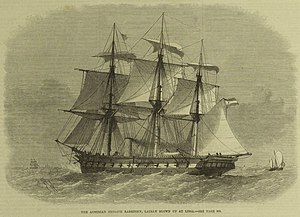
The Battle of Heligoland was fought on 9 May 1864, during the Second Schleswig War, between a Danish squadron led by Commodore Edouard Suenson and a joint Austro-Prussian squadron commanded by the Austrian Commodore Wilhelm von Tegetthoff. The action came about as a result of the Danish blockade of German ports in the North Sea; the Austrians had sent two steam frigates, SMS Schwarzenberg and Radetzky, to reinforce the small Prussian Navy to help break the blockade. After arriving in the North Sea, Tegetthoff joined a Prussian aviso and a pair of gunboats. To oppose him, Suenson had available the steam frigates Niels Juel and Jylland and the corvette Hejmdal.

The Battle of Lissa took place on 20 July 1866 in the Adriatic Sea near the Dalmatian island of Vis and was a significant victory for an Austrian Empire force over a numerically superior Italian force. It was the first major sea battle between ironclads and one of the last to involve deliberate ramming. The Italian navy fired roughly 1450 shots during the engagement but failed to sink any Austrian ship and lost two ironclads.

SMS Kaiser was a 92-gun wooden ship of the line of the Austrian Navy, the last vessel of the type, and the only screw-driven example, to be built by the Austrians. She was built by the naval shipyard in Pola; she was laid down in March 1855, was launched in October 1858, and was completed the following year. The ship took part in the Second Schleswig War of 1864, but saw no action during her deployment to the North Sea. Kaiser did see action during the Seven Weeks' War two years later, during which she took part in the Battle of Lissa as the flagship of Anton von Petz, commander of the Austrian 2nd Division. Kaiser engaged several Italian ironclads simultaneously, rammed one—Re di Portogallo—and damaged another—Affondatore—with gunfire. In doing so, she became the only wooden ship of the line to engage an ironclad warship in battle.
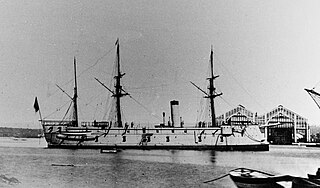
SMS Drache was the first of two Drache-class armored frigates built for the Austro-Hungarian Navy in the 1860s, the other being Salamander. Drache was laid down in February 1861, launched in September, and completed in November 1862. She remained in the Adriatic during the Second Schleswig War in 1864 while other ships were sent to attack Denmark. Two years later, Prussia and Italy attacked Austria in the Seven Weeks' War. The ship participated in the Austrian victory over the Italians in the Battle of Lissa, where she inflicted serious damage on the coastal defense ship Palestro, setting her on fire and ultimately destroying her. Drache was modernized immediately after the war, but saw little use thereafter. Badly rotted by 1875, she was stricken from the Navy List that year and eventually broken up in 1883.

SMS Salamander was a Drache-class armored frigate built for the Austro-Hungarian Navy in the 1860s; she was laid down in February 1861, launched in August that year, and completed in May 1862, six months before her sister Drache. She was a broadside ironclad, mounting a battery of twenty-eight guns in gun ports along the length the hull. During the Second Schleswig War in 1864, Salamander remained in the Adriatic to protect Austria from a possible Danish attack that did not materialize. Two years later, during the Seven Weeks' War, she participated in the Austrian victory over a superior Italian fleet in the Battle of Lissa in July 1866. Immediately after the war, she was modernized with a battery of more powerful guns. Little used thereafter owing to reduced naval budgets, she was stricken from the Navy List in 1883 and hulked for use as a mine storage ship before being broken up in 1895–1896.
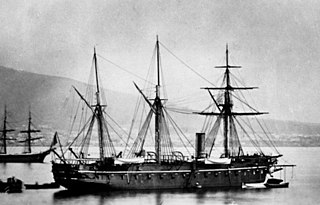
Principe di Carignano was the lead ship of the Principe di Carignano class of ironclad warships built for the Italian Regia Marina in the 1860s. She was the first ironclad built in Italy; her keel was laid January 1861, her hull was launched in September 1863, and she was completed in June 1865. Principe di Carignano was a broadside ironclad armed with a battery of ten 203 mm (8 in) guns and twelve 164 mm (6.5 in) guns.
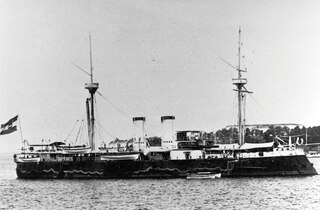
SMS Kronprinzessin Erzherzogin Stephanie was an ironclad warship built for the Austro-Hungarian Navy in the 1880s, the last vessel of that type to be built for Austria-Hungary. The ship, named for Archduchess Stephanie, Crown Princess of Austria, was laid down in November 1884, was launched in April 1887 and completed in July 1889. She was armed with a pair of 30.5-centimeter (12 in) guns in open barbettes and had a top speed of 17 knots. Her service was limited, in large part due to the rapid pace of naval development in the 1890s, which quickly rendered her obsolescent. As a result, her career was generally limited to routine training and the occasional visit to foreign countries. In 1897, she took part in an international naval demonstration to force a compromise over Greek and Ottoman claims to the island of Crete. Kronprinzessin Erzherzogin Stephanie was decommissioned in 1905, hulked in 1910, and converted into a barracks ship in 1914. After Austria-Hungary's defeat in World War I, the ship was transferred to Italy as a war prize and was eventually broken up for scrap in 1926.

SMS Lissa, named for the Battle of Lissa, was a unique ironclad warship built for the Austro-Hungarian Navy in the 1860s and 1870s, the only member of her class. She was the first casemate ship built for Austria-Hungary, she was armed with a main battery of twelve 9-inch (229 mm) guns in a central armored casemate, unlike the earlier broadside ironclads. Construction of the ship lasted from June 1867 to May 1871, and was delayed by budgetary shortfalls; the lack of funding also plagued the ship during her career, preventing her from taking an active role in the fleet. She spent the majority of her time in service laid up in Pola, apart from a lengthy reconstruction in 1880–1881. Lissa was ultimately stricken from the fleet in 1892 and broken up for scrap starting the following year.

The Erzherzog Ferdinand Max class consisted of a pair of ironclad warships—Erzherzog Ferdinand Max and Habsburg—built for the Austrian Navy in the 1860s. They were the last broadside armored frigates to be built for the Austrian Empire, and the last vessels completed to see action against the Italians at the Battle of Lissa in 1866. Intended to have been armed with new breech-loading Krupp guns, the outbreak of the Seven Weeks' War prevented the delivery of the guns, forcing the Austrian Navy to arm the ships with a battery of sixteen older 48-pounder muzzle-loading guns.

SMS Erzherzog Ferdinand Max was the lead ship of the Erzherzog Ferdinand Max class of broadside ironclads built for the Austrian Navy in the 1860s. She was built by the Stabilimento Tecnico Triestino, with her keel laying in October 1863, launching in May 1865, and commissioning in June 1866 at the outbreak of the Third Italian War of Independence and the Austro-Prussian War, fought concurrently. The ship was armed with a main battery of sixteen 48-pounder guns, though the rifled guns originally intended, which had been ordered from Prussia, had to be replaced with old smoothbore guns until after the conflicts ended.

SMS Habsburg was the second and final member of the Erzherzog Ferdinand Max class of broadside ironclads built for the Austrian Navy in the 1860s. She was built by the Stabilimento Tecnico Triestino; her keel was laid down in June 1863, she was launched in June 1865, and commissioning in June 1866 at the outbreak of the Third Italian War of Independence and the Austro-Prussian War, fought concurrently. The ship was armed with a main battery of sixteen 48-pounder guns, though the rifled guns originally intended, which had been ordered from Prussia, had to be replaced with old smoothbore guns until after the conflicts ended.

The Kaiser Max class of broadside ironclads was a group of three vessels built for the Austro-Hungarian Navy in the 1860s. The class consisted of Kaiser Max, the lead ship, Prinz Eugen, and Don Juan d'Austria. They were an improved version of the preceding Drache class, being larger, carrying a larger gun battery, and having more powerful engines. The three ships were all laid down in 1861, launched in 1862, and completed in 1863.
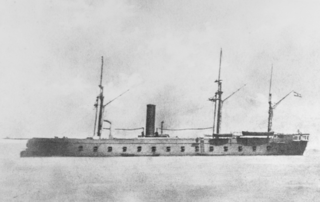
SMS Kaiser Max was the lead ship of the Kaiser Max class of armored frigates built for the Austrian Navy in the 1860s. Her keel was laid in October 1861 at the Stabilimento Tecnico Triestino shipyard; she was launched in May 1862, and was completed in 1863. She carried her main battery—composed of sixteen 48-pounder guns and fifteen 24-pounders—in a traditional broadside arrangement, protected by an armored belt that was 110 mm (4.3 in) thick.

SMS Prinz Eugen was the second member of the Kaiser Max class built for the Austrian Navy in the 1860s. Her keel was laid in October 1861 at the Stabilimento Tecnico Triestino shipyard; she was launched in June 1862, and was completed in March 1863. She carried her main battery—composed of sixteen 48-pounder guns and fifteen 24-pounders—in a traditional broadside arrangement, protected by an armored belt that was 110 mm (4.3 in) thick.

SMS Don Juan d'Austria was the third member of the Kaiser Max class built for the Austrian Navy in the 1860s. Her keel was laid in October 1861 at the Stabilimento Tecnico Triestino shipyard; she was launched in July 1862, and was completed in 1863. She carried her main battery—composed of sixteen 48-pounder guns and fifteen 24-pounders—in a traditional broadside arrangement, protected by an armored belt that was 110 mm (4.3 in) thick.
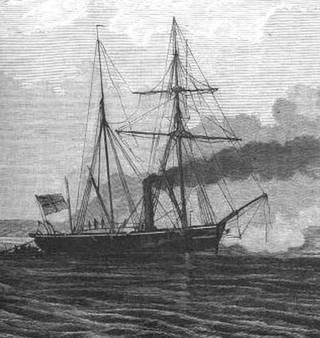
SMS Blitz was a Camäleon-class gunboat of the Prussian Navy that was launched in 1862. A small vessel, armed with only three light guns, Blitz served during all three wars of German unification in the 1860s and early 1870s. The ship was present during the Battle of Heligoland in May 1864 during the Second Schleswig War, but was too slow to engage the Danish squadron. During the Austro-Prussian War of 1866, she operated against the Kingdom of Hanover in the North Sea, but did not see extensive action. In August 1870, Blitz and three other light vessels attacked the French blockade force in the Baltic Sea during the Franco-Prussian War, but they withdrew without either side scoring any hits. During her peacetime career, Blitz was sent to the Mediterranean Sea twice, in 1863 and 1867–1868. She was employed as a fisheries protection ship, a guard ship, and a survey vessel in the early 1870s, before being decommissioned in 1875 and broken up for scrap in 1878. Parts of her machinery were reused in the gunboat Wolf.

SMS Basilisk was a Camäleon-class gunboat of the Prussian Navy that was launched in 1862. A small vessel, armed with only three light guns, Basilisk served during all three wars of German unification in the 1860s and early 1870s. The ship was present during the Battle of Heligoland in May 1864 during the Second Schleswig War, but was too slow to engage the Danish squadron. During the Austro-Prussian War of 1866 and the Franco-Prussian War of 1870–1871, Basilisk was stationed in the North Sea to help defend the coast, but she did not see action during either conflict. Between 1873 and 1875, she was employed experimentally as the first torpedo-armed warship of the German fleet. Basilisk was decommissioned in 1875, renamed "Mine Barge No. 1", and converted into a naval mine storage hulk. The details of her fate are unrecorded, but she was still in service in that capacity at least as late as 1900. Sometime thereafter, she was broken up.

The Camäleon class was a group of gunboats built for the Prussian Navy. Eight ships comprised the class: Camäleon, Comet, Cyclop, Delphin, Blitz, Basilisk, Meteor, and Drache. The vessels were armed with a battery of one 15 cm (5.9 in) gun and two 12 cm (4.7 in) guns. In 1865, the ships then in service had their 15 cm gun replaced with a 21 cm (8.3 in) gun; Meteor and Drache, not yet completed, entered service with that gun. The vessels saw action during the wars of German unification, with Comet taking part in the Battle of Jasmund and Blitz and Basilisk present during the Battle of Heligoland, both during the Second Schleswig War in 1864. Several of the ships served in the North Sea during the Austro-Prussian War, where some of them supported operations against the Kingdom of Hanover. During the Franco-Prussian War, Meteor battled the French aviso Bouvet in the Battle of Havana in 1870; the other members of the class were deployed on coastal defense assignments.

SMS Preussischer Adler was a paddle steamer originally built in the mid-1840s for use on a packet route between the Kingdom of Prussia and the Russian Empire in the Baltic Sea. She was requisitioned by the Prussian Navy during the First Schleswig War in 1848 and converted into an aviso, the first vessel of the type commissioned by Prussia. During the war, she took part in an inconclusive action with the Danish brig St. Croix, the first naval battle of the Prussian fleet. After the war, she was disarmed and returned to her commercial role, operating uneventfully on the Stettin–St. Petersburg route until 1862, when the expansion of the Prussian Eastern Railway had rendered the maritime route superfluous. The ship was purchased by the Prussian Navy that year and rearmed, once again as an aviso.
